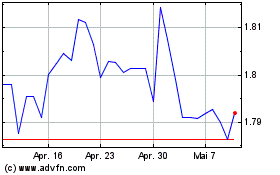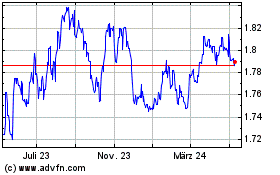Commodity Currencies Drop After Trump's New Tariff Threats
26 November 2024 - 3:01AM
RTTF2
The commodity currencies such as Australia, the New Zealand and
the Canadian dollars weakened against their major currencies in the
Asian session on Tuesday, after U.S. President-elect Donald Trump
announced a 10 percent additional tariff on all Chinese goods and a
25 percent tariff on imports from Mexico and Canada, raising
concerns over global trade tensions.
This measure was to cut down migrants and illegal drugs flowing
across U.S. borders at levels never seen before, he said.
Traders also seemed reluctant to make more significant moves
ahead to the release of key U.S. economic data later in the week,
including readings on consumer price inflation preferred by the
U.S. Fed.
Weakness in financial and energy stocks amid tumbling crude oil
prices, also weighed on the investor sentiment.
Crude oil prices fell sharply, weighed down by reports that
Israel and Hezbollah are likely to reach a cease-fire agreement
within the next few days. West Texas Intermediate Crude oil futures
for January ended down $2.30 or 3.2 percent at $68.94 a barrel.
In the Asian trading today, the Australian dollar fell to nearly
a 4-month low of 0.6434 against the U.S. dollar and nearly a
2-month low of 99.08 against the yen, from yesterday's closing
quotes of 0.6502 and 100.27, respectively. If the aussie extends
its downtrend, it is likely to find support around 0.63 against the
greenback and 96.00 against the yen.
Against the euro and the NZ dollar, the aussie slipped to a
6-day low of 1.6212 and a 5-day low of 1.1088 from Monday's closing
quotes of 1.6130 and 1.1122, respectively. On the downside, 1.66
against the euro and 1.09 against the kiwi are seen as the next
support levels for the aussie.
The NZ dollar fell to a 1-yr low of 0.5797 against the U.S.
dollar, from yesterday's closing value of 0.5845. The kiwi may test
support near the 0.56 region.
Against the yen and the euro, the kiwi slid to more than a
2-month low of 89.35 and a 1-week low of 1.7997 from Monday's
closing quotes of 90.14 and 1.7951, respectively. If the kiwi
extends its downtrend, it is likely to find support around 88.00
against the yen and 1.82 against the euro.
The Canadian dollar fell to more than a 4-1/2-yr low of 1.4178
against the U.S. dollar and more than a 1-month low of 108.61
against the yen, from yesterday's closing quotes of 1.3986 and
110.24, respectively. If the loonie extends its downtrend, it is
likely to find support around 1.42 against the greenback and 107.00
against the yen.
Against the euro and the Australian dollar, the loonie dropped
to a 6-day low of 1.4788 and a 2-week low of 0.9161 from Monday's
closing quotes of 1.4677 and 0.9094, respectively. The next
possible downside target for the loonie is seen around 1.51 against
the euro and 0.93 against the aussie.
Looking ahead, U.S. building permits for October, house price
index for September, U.S. Consumer Board's consumer confidence for
November, U.S. new home sales for October, U.S. Richmond
manufacturing index for November and Canada wholesale sales data
for October are slated for release in the New York session.
At 2:00 pm ET, the minutes from the Federal Open Market
Committee's Nov. 6-7 meeting will be published.
Euro vs NZD (FX:EURNZD)
Forex Chart
Von Okt 2024 bis Nov 2024

Euro vs NZD (FX:EURNZD)
Forex Chart
Von Nov 2023 bis Nov 2024


